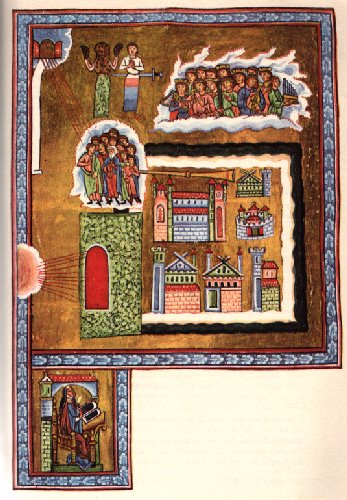by Mark Vornhusen

“And again 1 looked: A gigantic city. It was laid out quadrilateral and partially had a special glare, but a part of it was surrounded by certain glooms like by a wall. In its eastern region I saw a mighty and high mountain made of hard and pale stone, shaped like a volcanic mountain, from the top of which a kind of mirror shone up with such a clarity and purity that it seemed to put into shade even the glare of the sun. In that mirror a dove rose with its wings spread as if it wanted to fly away. The mirror hid a lot of secrets inside. It emitted a glare of great width and height, in which appeared a lot of mysteries and various figures of a variety of statues.”
Just like St. John of Jerusalem's revelation does, Hildegard also describes the city as quadrilateral. The parhelic circle, however, is shaped like a circle. Despite of this, only the parhelic circle can be considered as the City wall It is possible that, just like St. John did, also Hildegard thought of the holy City of Jerusalem when she had the vision. In the Bible, Jerusalem is described with a square outline. But it is also possible that at low sun elevations people regard the parhelic circle as quadrilateral. The mountain is the 22°-halo which now cannot he seen completely, but only its upper part. On top of it there is "a mirror which seemed to put into shade the glare of the sun". This is the very bright area between the upper tangent arc and the Parry arc. The spread wings of the dove are equal to the upper tangent arc.
“In the same glare, towards the south, a cloud appeared, bright1y white on its upper and black on its lower side. Above it a large group of angels shone up, some of which were shining like fire, others brightly, and others like stars. They all were moved like burning torches by a wind. And they were also full of voices which sounded like the roaring of the sea. And each wind rose its voice with the power of anger and thus unleashed a fire against the mentioned blackness of the cloud. So this cloud burned without any flame towards the blackness. But soon it blew into it letting it disperse and vanish like thick smoke. So it chased the dispersing cloud from the south over the mountain I mentioned towards the north into an immense abyss. From now on it could not rise any more and only let a cover of fog pass over the earth.”
Here Hildegard describes clouds. A part of the clouds disperses in thick smoke. It is possible that she describes virgae which can cause very bright halos. In the clouds there is a red and white flare. As Hildegard does not tell the exact position, it is impossible to say exactly which types of halos caused this flare. It is possible that it was caused by parts of sundogs or of the supralateral and infralateral arc.
“And I heard trombones sounding from the sky: But what is it that decayed despite all the power of its own? And so the white part of the cloud I mentioned shone even more beautiful than before. But from now on nobody was able to resist the wind that had chased away the blackness of the cloud I mentioned by the power of its triple voice. And again I heard a voice speaking from the sky (...)”
Also here clouds are described. Even clouds that consist of ice crystals can shine up brightly near the sun.